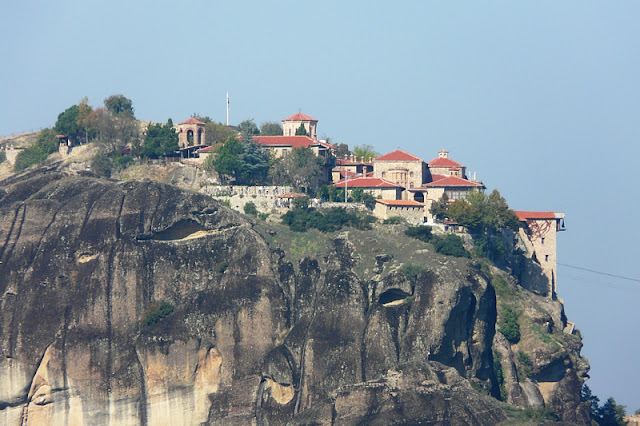Monastyr Wielki Meteor (Przemienienia Pańskiego) jest jednym z sześciu monastyrów w kompleksie Meteory w Grecji. Jest on najstarszym, największym i najwyżej położonym.
Monastery The Great Meteoron (Monastery of the Transfiguration of Christ) is one of the six monasteries of the Meteora in Greece. It is the highest, largest and oldest one.
Monastyr Wielki Meteor, The Monastery of Great Meteoron
Monastyr Wielki Meteor został założony około 1340 roku przez św. Atanazego, mnicha z góry Athos. Według legendy został on przeniesiony przez orła na skałę, na której zbudował kościół. Abstrahując od legendy, św. Atanazy zbudował początkowo mały kościół i skromne cele dla mnichów, dedukując je Maryi Dziewicy. W okresie późniejszym dobudowano większy kościół, pod wezwaniem Przemienienie Pańskiego, które objęło cały powstający klasztor.
The Great Meteoron was established around 1340 by St. Athanasios Meteorites, a scholarly monk from Mount Athos. Legend says he was carried up by an eagle to the rock, where he built church. Apart from this legend St. Athanasios first built a small church and modest lodgings for monks, dedicating both to the Virgin Mary. Later he added a larger church dedicated to the Transfiguration of Christ, which became the primary dedication of the monastery.
Monastyr Wielki Meteor, The Monastery of Great Meteoron.
Następcą Atanzego był św. Joasaf, który był wcześniej Serbskim królem zwanym jako Jan Uresis. Jednak około 1373 roku został on mnichem. Rozbudował on główny kościół (w latach 1387-1388) oraz dobudował kilka budynków, m. in. cele mnichów i szpital.
Athanasios' successor was Saint Iosaph, a Serbian king formerly known as John Uros who become a monk here in c.1373. He rebuilt the Church of the Transfiguration (1387-88) and added monastic building including monks' cells, and a hospital.
Monastyr Wielki Meteor, The Monastery of Great Meteoron.
Największy rozkwit klasztoru przypadł na XVI wiek, kiedy mnisi otrzymali pokaźne dotacje. Kościół Przemienienia Pańskiego został rozbudowany w latach 1544-1545, a cały kompleks poszerzył się o nową kuchnię, wieżę, dom starców i refektarz.
The Great Meteoron reached its peak in the 16th century, when it received significant imperial and royal donations. The Church of the Transfiguration were rebuilt in 1544-45 and the monastic complex was expanded later in the century with a new kitchen, a tower, a home for the aged, a refectoryand several chapels.
Monastyr Wielki Meteor, The Monastery of Great Meteoron.
Na przełomie XX i XXI stulecia wszystkie zabudowania monastyru poddano gruntownej renowacji: zmodernizowano cele mnichów i zaplecze, zrekonstruowano dawne hospicjum i urządzono w nim muzeum sakralno-historyczne, oczyszczono freski w kościele głównym.
At the turn of the twentieth and twenty-first century, the monastery buildings were all a complete renovation: modernization and meeting the objectives of the monks, former hospice reconstructed and furnished in the sacral and historical museum, cleaned frescoes in the main church.
Monastyr Wielki Meteor, przejście przez skały, The Monastery of Great Meteoron, passage through the rocks.
Do najważniejszych zabytków Wielkiego Meteora, które zostały udostępnione do zwiedzania, należą: główny kościół (Katolikon) pod wezwaniem Przemienienia Pańskiego, wieża z balkonem, ossuarium i refektarz. Oprócz powyższych obiektów na terenie monastyru znajdują się jeszcze, nie udostępnione do zwiedzania: szpital-dom starców, oraz kaplice pod wezwaniem: Matki Bożej (z XIV wieku), św. Jana Chrzciciela (z XVII wieku), świętych Konstantego i Heleny (z 1789 roku) oraz św. Nektariusza.
The most important monuments of the Great Meteora, which are open to the public, include the main church (Katolikon) dedicated to the Transfiguration of the Christ, a tower with a balcony, ossuary and the refectory. In addition to these objects in the monastery are still not open to the public: a hospital-nursing home, and chapels dedicated to Our Lady (the fourteenth century), St. John the Baptist (the seventeenth century), Saints Constantine and Helena (from 1789) and St. Nectarius.
Monastyr Wielki Meteor, Kościół Przemienienia Pańskiego, The Monastery of Great Meteoron, Church of the Transfiguration of Christ.
Na kościół Przemienienia Pańskiego składa się katholikon zbudowany przez św Joasafa w 1388 oraz nawa i soboty dodane w 1544/45. Katholikon zbudowany jest na planie greckiego krzyża i posiada 12 boczną kopułę centralną opartą na bębnie. Ikony zdobiące ikonostas pochodzą z XIV-XVI wieku. Natomiast freski są datowane na 1497/98 i są dobrze zachowane. Są one malowane w stylu macedońskim.
The Church of the Transfiguration consists of the katholikon built by Saint Ioasaph's in 1388 and a nave and narthex added in 1544-45. The katholikon has a Greek-cross-in-square floor plan, with a 12-sided central dome resting on a drum. The icons adorning the iconostasis date from the 14th to 16th centuries. The frescoes of the katholikon date from 1497-98 and are well-preserved. They are painted in the Macedonian style.
Monastyr Wielki Meteor, wieża, The Monastery of Great Meteoron, tower.
Wieża wyciągowa z balkonem pochodzi z 1520 roku. To na nią niegdyś mnisi byli wciągani przy pomocy sieci, aby dostać się do monastyru. Mieści się w niej obecnie muzeum, w którym są eksponowane stare naczynia i narzędzia pracy oraz stary sprzęt gospodarczy używany niegdyś w klasztorze.
The tower with balcony was built in 1520. It was used to transport the monks and various objects by ropes and nets. Now it is housed in a museum, where they are exposed the old crockery and old tools and household appliances used in the convent once.
Monastyr Wielki Meteor, wieża, The Monastery of Great Meteoron, tower.
Opatowi Wielkiego Meteoru od 1940 podlegają wszystkie pozostałe klasztory meteorskie, tutaj przechowuje się najwięcej dokumentów i relikwii.
Abbot of the Great Meteor from 1940 leading also other monasteries of Meteora. Here is stored many documents and relics.








